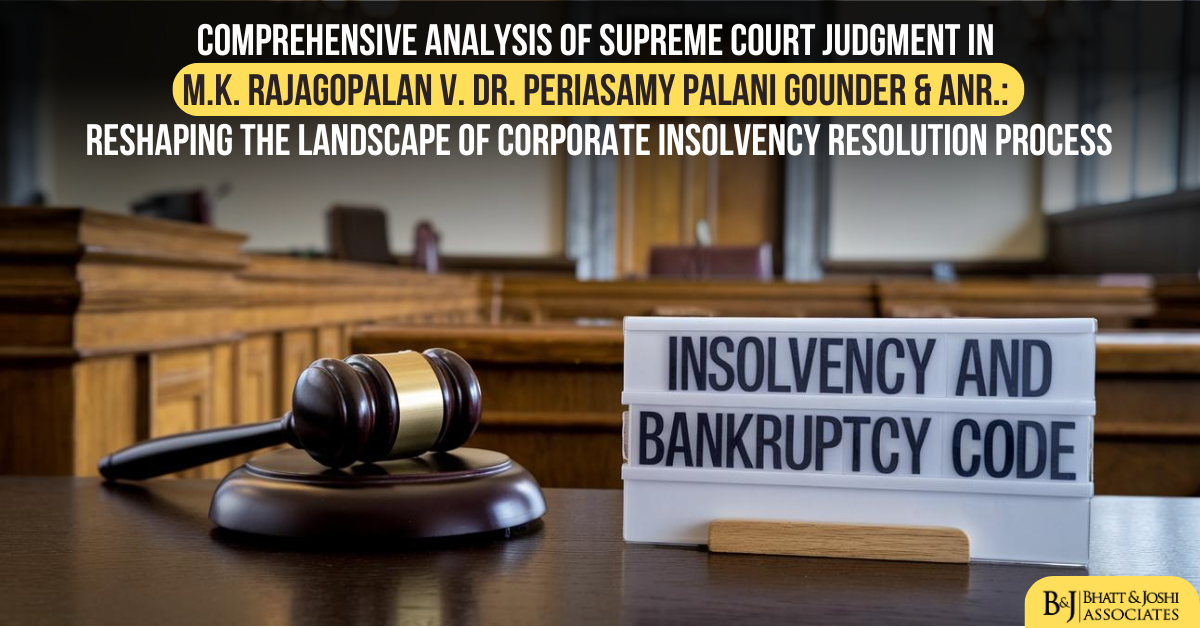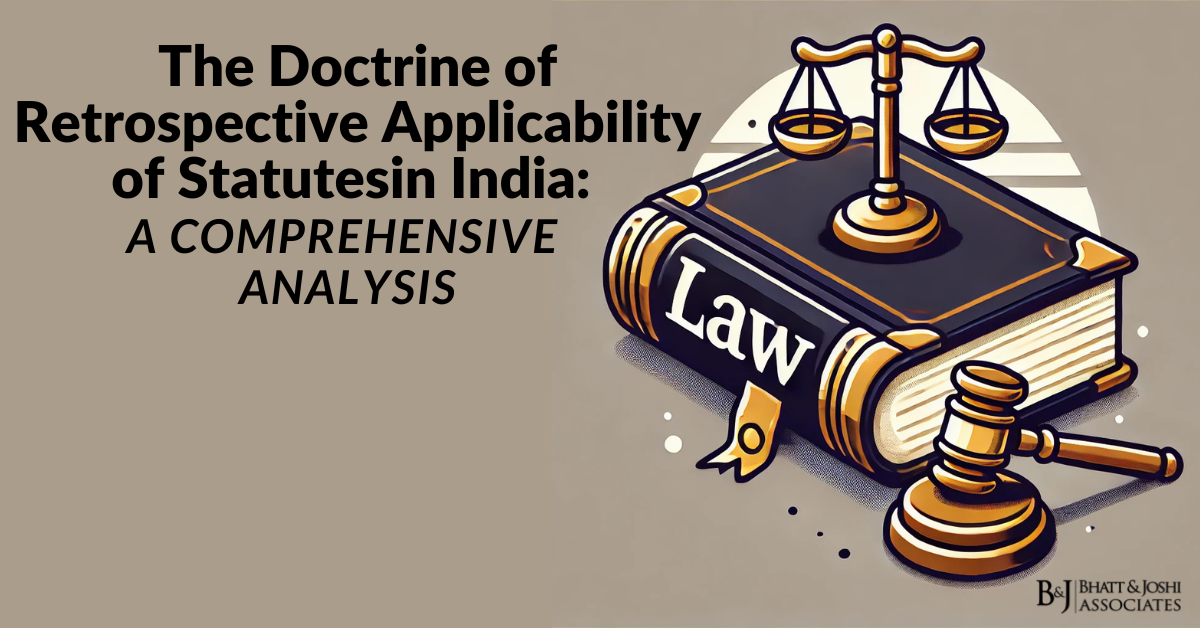Introduction:
The Supreme Court’s judgment in M.K. Rajagopalan v. Dr. Periasamy Palani Gounder & Anr., delivered on May 3, 2023, marks a significant milestone in the evolving jurisprudence of the Insolvency and Bankruptcy Code (IBC). This case, involving appeals against a National Company Law Appellate Tribunal (NCLAT) order that had set aside the approval of a resolution plan for Appu Hotels Limited, provides crucial insights into various aspects of the corporate insolvency resolution process (CIRP). The Court’s decision meticulously examines and clarifies several contentious issues, including the eligibility of resolution applicants, the sanctity of the Committee of Creditors’ (CoC) decisions, the process of plan approval, and the consideration of settlement offers under Section 12A of the IBC.
Background of the Case: M.K. Rajagopalan v. Dr. Periasamy Palani Gounder
The case revolved around the CIRP of Appu Hotels Limited, which was initiated on May 5, 2020, upon admission of an application by Tourism Finance Corporation of India Limited under Section 7 of the IBC. The resolution plan submitted by M.K. Rajagopalan was approved by the CoC with 87.39% voting share. However, the National Company Law Tribunal’s (NCLT) approval of this plan was challenged before the NCLAT, which set aside the approval on various grounds. The Supreme Court was then approached to adjudicate on the NCLAT’s decision.
Detailed Analysis of Key Issues:
- Valuation Process and Reports:
The Court meticulously examined the allegation that the valuation process violated Regulations 27 and 35 of the CIRP Regulations. It noted that:- The CoC members were provided with fair value and liquidation value after obtaining confidentiality undertakings.
- The resolution professional had appointed registered valuers for all three categories of assets.
- The CoC was fully satisfied with and endorsed the valuation process, including re-evaluation.
- The NCLT had independently scrutinized the valuation process and found no errors.
The Court emphasized that a resolution plan is not required to match the liquidation value, referencing its earlier decision in Maharashtra Seamless Ltd. v. Padmanabhan Venkatesh. It concluded that the NCLAT’s findings regarding valuation contravening Sections 30(2) and 61(3) of the IBC were unsustainable.
- Publication of Form G:
The Court addressed the issue of non-publication of Form G on the designated website as mandated by Regulation 36A(2)(iii) of the CIRP Regulations. It ruled that:- Form G was published in all leading newspapers on August 9, 2020.
- The resolution professional had informed IBBI about technical issues in uploading the form on the website.
- All requisite steps had been reasonably taken.
- No prejudice was shown by anyone due to this technical non-compliance.
The Court rejected the NCLAT’s observation that publication on websites was crucial during the COVID-19 pandemic when people avoided newspapers. It held that this procedural irregularity was not material enough to vitiate the entire CIRP.
- Eligibility of Resolution Applicant:
The Court dealt with two aspects of the resolution applicant’s eligibility:The Court disagreed with NCLAT’s finding that the applicant was ineligible due to alleged non-refund of share application money by another company where he was a director. It held that:Under Section 164(2)(b) of the Companies Act:- There is no concept of deemed disqualification under Section 164(2)(b).
- A specific order disqualifying the applicant as director by the competent authority was necessary for such ineligibility.
- The applicant’s DIN status was “active compliant”, indicating no disqualification.
Under Section 88 of the Indian Trusts Act:
The Court upheld NCLAT’s finding on this aspect. It noted that:- The trust “Sri Balaji Vidyapeeth”, of which the applicant was managing trustee, was disqualified as a resolution applicant.
- The applicant had submitted two EOIs – one in individual capacity and one on behalf of the trust.
- The applicant’s resolution plan relied on his status as managing trustee of the trust for financial credentials.
- This created a conflict of interest under Section 88 of the Trusts Act.
The Court concluded that the applicant could not be detached from the ineligible trust, and any pecuniary advantage gained by him would be subsumed by Section 88 of the Trusts Act.
- Approval Process for Revised Resolution Plan:
The Court found a material irregularity in the process of approval of the revised resolution plan. It held that:- The plan approved by CoC in its 9th meeting was sent back for revision to comply with Section 30(2) of IBC regarding payment to dissenting financial creditors.
- The revised plan with altered financial layout was directly submitted to NCLT without being placed before CoC again.
- This process violated the scheme of IBC and CIRP regulations.
- Each aspect of a resolution plan, particularly its financial layout, must be considered by CoC before it can be said to have arrived at a considered decision.
- There can be no concept of post-facto approval by CoC of a plan submitted to NCLT.
- The Court emphasized that this was not a mere technicality but a material irregularity that could not be cured.
- Treatment of Related Party:
The Court disagreed with NCLAT’s observations on non-discrimination between related and unrelated creditors in the resolution plan. It held that:- There is no provision in the IBC mandating that related parties should be paid at par with unrelated parties.
- Differential payment to different classes of creditors in a resolution plan is subject to CoC’s commercial wisdom.
- The resolution plan cannot be faulted merely for not making provisions for a related party.
- Consideration of Settlement Offer:
The Court found that NCLAT erred in holding that the settlement offer of the promoter under Section 12A of IBC was not properly considered by CoC. It noted that:- The settlement proposal was put forth just a day before CoC was to vote on the resolution plan.
- CoC did consider the proposal in its 9th meeting but decided not to deviate from the agenda.
- Creditors with substantial voting share were against considering such a last-minute proposal.
- An application for withdrawal under Section 12A requires 90% voting share approval, which was clearly not possible given the stance of major creditors.
- Subsequent Events and Section 12A Proposal:
The Court took note of subsequent events, including:- Fresh invitation for EOIs after NCLAT’s order.
- Approval of a new settlement proposal by the promoter with 100% voting share in the 19th CoC meeting.
- While acknowledging the CoC’s approval, the Court refrained from giving a blanket approval to this settlement. It directed the NCLT to consider all relevant aspects, including the justification for invoking Section 12A after issuance of fresh EOI and receipt of resolution plans.
Conclusion: Impact of M.K. Rajagopalan v. Dr. Periasamy Palani Gounder on Insolvency Resolution
The Supreme Court’s judgment in M.K. Rajagopalan v. Dr. Periasamy Palani Gounder provides a comprehensive framework for understanding and implementing various aspects of the CIRP under the IBC. While upholding the NCLAT’s rejection of the resolution plan, the Court disagreed with many of NCLAT’s reasonings, offering a more nuanced interpretation of the IBC provisions.
Key takeaways from the judgment include:
- Minor procedural irregularities will not vitiate the entire CIRP process, but material irregularities like not placing a revised plan before CoC cannot be overlooked.
- The commercial wisdom of CoC should be respected, but it cannot override clear legal requirements or brush aside shortcomings in decision-making.
- There is no concept of deemed disqualification of resolution applicants; specific orders from competent authorities are necessary for such disqualification.
- The conflict of interest provisions under the Trusts Act can render a resolution applicant ineligible, even if submitting a plan in individual capacity.
- Related party treatment in resolution plans is subject to CoC’s commercial wisdom and does not mandate parity with unrelated creditors.
- Settlement proposals under Section 12A must be timely and cannot be used as a tactic to delay or derail the CIRP process.
This judgment strikes a delicate balance between respecting the CoC’s commercial decisions and ensuring strict compliance with statutory requirements. It provides valuable guidance for insolvency professionals, creditors, and resolution applicants on navigating the complex terrain of corporate insolvency resolution. The Court’s decision to leave the consideration of subsequent settlement proposals to the adjudicating authority also underscores the dynamic nature of the CIRP and the need for case-specific assessment. The judgment is likely to have far-reaching implications on future CIRPs, particularly in terms of ensuring transparency in the resolution plan approval process, assessing the eligibility of resolution applicants, and balancing the interests of various stakeholders in the insolvency ecosystem.
Written by:
SNEH RAJESH PUROHIT ADVOCATE
Bibliography:
- Insolvency and Bankruptcy Code, 2016
- Companies Act, 2013
- Indian Trusts Act, 1882
- IBBI (Insolvency Resolution Process for Corporate Persons) Regulations, 2016
- Committee of Creditors of Essar Steel India Limited v. Satish Kumar Gupta, (2020) 8 SCC 531
- Swiss Ribbons Pvt. Ltd. v. Union of India, (2019) 4 SCC 17
- K. Sashidhar v. Indian Overseas Bank, (2019) 12 SCC 150
- Maharashtra Seamless Ltd. v. Padmanabhan Venkatesh, (2020) 11 SCC 467
- Phoenix ARC Pvt. Ltd. v. Spade Financial Services Ltd., (2021) 3 SCC 475
- Jaypee Kensington Boulevard Apartments Welfare Association v. NBCC (India) Ltd., (2022) 1 SCC 401
- Brilliant Alloys Pvt. Ltd. v. S. Rajagopal, (2022) 2 SCC 544
- Vallal RCK v. Siva Industries and Holdings Ltd., 2022 SCC OnLine SC 717
- Report of the Bankruptcy Law Reforms Committee, November 2015
- IBBI Circular No. IP(CIRP)/006/2018 dated 23.02.2018
- Companies (Acceptance of Deposits) Rules, 2014














